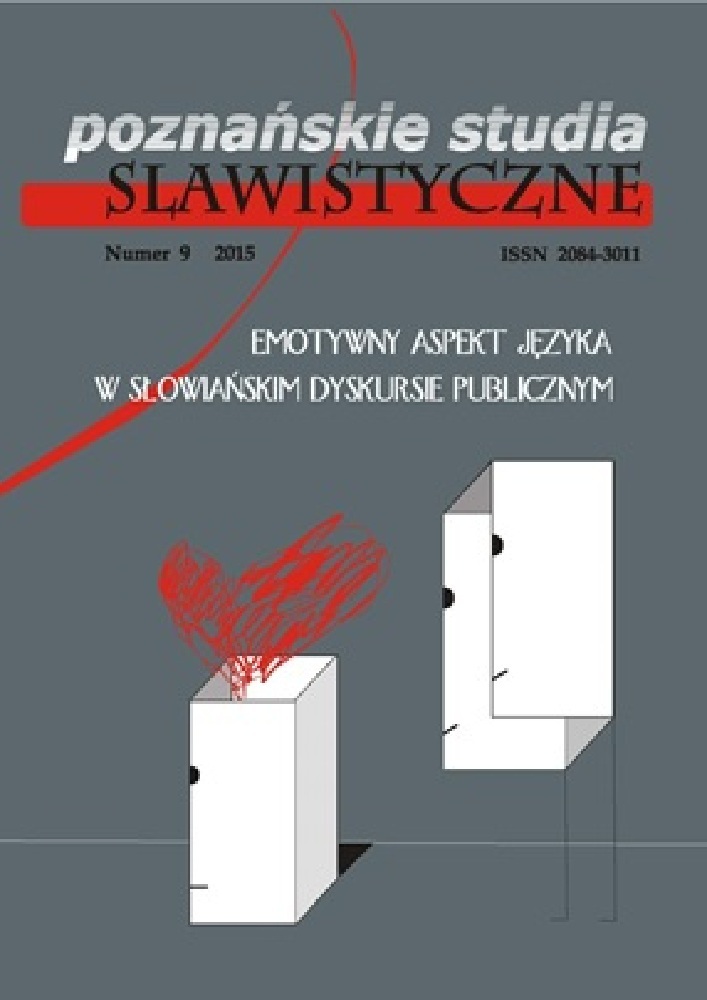Abstract
Emotion may be treated as a special sort of message considering that communicative function is one of the basic functions of emotion. Moreover emotion serves as a message in two ways. In one way facial expression of emotion is a message to other participants of social interaction that contains information about the emotional state of the subject and thus plays important interpersonal role. It shows the subject’s personal attitude and amplifies verbal messages or makes them more credible. Numerous empirical studies show that processes of generating and perceiving of facial expressions of emotions are autonomic and specific. In the other way emotion is an internal message containing information about the significance of events or thoughts and thus helping in making choices or taking decissions.
References
Buck R., 1994, Social and emotional functions in facial expression and communication: The readout hypothesis, „Biological Psychology” 38, s. 95–115.
Caron A., Caron R., MacLean D., 1988, Infant discrimination of naturalistic emotional expressions: The role of face and voice, „Child development” no. 59, s. 604–616.
Damasio A., 1999, Błąd Kartezjusza. Emocje, rozum i ludzki mózg, Poznań.
Damasio A., Tranel D., Damasio H., 1991, Somatic markers and the guidance of behavior: Theory and preliminary testing, w: Frontal Lobe Function and Disfunction, ed. H. Levin, H. Eisenberg, A. Benton, New York, s. 217–229.
Darwin C., 1872, The expression of the emotions in man and animals, New York. http://dx.doi.org/10.1037/10001-000
Ekman P., 1984, Expression and the nature of emotion, w: Approaches to emotion, ed. K. Scherer, P. Ekman, New York, s. 135–148.
Ekman P., 1992, An argument for basic emotions, „Cognition and Emotion” no. 6, s. 169–200.
Ekman P., 1999, Basic emotions, w: Handbook of cognition and emotion, ed. T. Dalgleish, M. Power, New York, s. 257–269.
Ekman P., Davidson R., Friesen W., 1990, The Duchenne smile: Emotional expression and brain physiology, „Journal of Personality and Social Psychology” no. 58, s. 342–353.
Ekman P., Friesen W., 1974, Detecting deception from body or face, „Journal of Personality and Social Psychology” 29, s. 288–298.
Ekman P., Friesen W., 1975, Unmasking the face: A guide to recognizing emotions from facial clues, Prentice Hall.
Ekman P., Friesen W., 1982, Felt, false and miserable smiles, „Journal of Nonverbal Behavior” no. 6, s. 238–252.
Frijda N., 1986, The emotions, Cambridge.
Gobbini M., Haxby J., 2007, Neural systems for recognition of familiar faces, „Journal of Neurophysiology” no. 45, s. 32–41.
Gross J., 1998, The emerging field of emotion regulation: An integrative review, „Review of General Psychology” no. 2, s. 271–299.
Izard C., 1994, Innate and universal facial expressions: Evidence from developmental and cross-cultural research, „Psychological Bulletin” no. 115, s. 288–299.
Izard C., Abe J., 2004, Developmental changes in facial expressions of emotions on the strange situation during the second year of life, „Emotion” 4, s. 251–265.
Keltner D., Ekman P., 2005, Wyrażanie emocji twarzą, w: Psychologia emocji, red. M. Lewis, J. Haviland-Jones, Gdańsk, s. 307–323.
Lazarus R., 1991, Emotion and adaptation, New York.
LeDoux J., 2000, Mózg emocjonalny. Tajemnicze podstawy życia emocjonalnego, Poznań.
LeDoux J., Phelps E., 2005, Sieci emocjonalne w mózgu, w: Psychologia emocji, red. M. Lewis, J. Haviland-Jones, Gdańsk, s. 210–229.
Łosiak W., 2007, Psychologia emocji, Warszawa.
Matsumoto D., LeRoux D., Wilson-Cohn C., Raroque J., Kooken K., Ekman P., 2000, A new test to measure emotion recognition ability: Matsumoto and Ekman’s Japanese and Caucasian Brief Affect Recognition Test (JACBART), „Journal of Nonverbal Behavior” no. 24, s. 179–209.
Matsumoto D., Yoo S., Hirayama S., Petrova G., 2005, Development and validation of a measure of display rule knowledge: The display rule assessment inventory, „Emotions” no. 5, s. 23–40.
McNeil J., Warrington E., 1993, Prosopagnosia: a face specific disorder, „Quarterly Journal of Experimental Psychology Section A: Human Experimental Psychology” no. 46, s. 1–10.
Mehrabian A., 1971, Silent messages, Belmont.
Morris J., de Gelder B., Weiskrantz L., Dolan R., 2001, Differential extrageniculostriate and amygdala responses to presentation of emotional faces in a cortically blind field, „Brain” no. 124, s. 1241–1252.
Ohman A., 2002, Automaticity and the amygdala: Nonconscious responses to emotional faces, „Current Directions in Psychological Science” no. 11, s. 62–66.
Ohme K., Augustynowicz M., Kukliński K., 2001, Przedświadome rozróżnianie ekspresji mimicznej, „Studia Psychologiczne” nr 39, s. 29–40.
Plutchnik R., 1980, Emotion. A psychoevolutionary synthesis, New York.
Rosenberg E., Ekman P., 1997, Coherence between expressive and experiental systems in emotion, w: What the face reveals: Basic and applied studies of spontaneous expression using the Facial Action Coding System (FACS), ed. P. Ekman, E. Rosenberg, New York, s. 63–88.
Russell J., 1991, The contempt expression and the relativity thesis, „Motivation and Emotion” no. 15, s. 149–168.
Scherer K., 1986, Vocal affect expression: A review and a model for future research. „Psychological Bulletin” no. 99, s. 143–165.
Scherer K. 1989, Vocal correlates of emotion, w: Handbook of psychophysiology: Emotion and social behavior, ed. A. Manstead, H. Wagner, Chichester, s. 165–197.
Stein N., Levine L., 1989, The casual organization of emotion knowledge: a developmental study, „Cognition and Emotion” no. 3, s. 343–378.
Stein N., Levine, L., 1999, The early emergence of emotional understanding and appraisal: Implications for theories of development, w: Handbook of cognition and emotion, ed. T. Dalgleish, M. Power, New York, s. 304–325.
Streit M., Ioannides, A., Liu L., Wolwer W., Dammers J., Gross J., Gaebel W., Muller-Gartner H., 1999, Neurophysiological correlates of the recognition of facia expressions of emotion as revealed by magnetoencephalography, „Cognitive Brain Research” no. 7, s. 481–491.
Tooby, J., Cosmides, L., 1990, The past explains the present: Emotional adaptations and the structure of ancestral environments, „Ethology and Sociobiology” no. 11, s. 375–424.
Wronka, E., 2012, Mózgowe podłoże rozpoznawania ekspresji emocjonalnej, Kraków.
Zajonc R., 1980, Feeling and thinking: Preferences need no inferences, „American Psychologist” no. 35, s. 151–175.
Zajonc R., 1999, Dowody na istnienie emocji nieświadomych, w: Natura emocji. Podstawowe zagadnienia, red. P. Ekman, R. Davidson, Gdańsk.
License

This work is licensed under a Creative Commons Attribution-NoDerivatives 4.0 International License.
